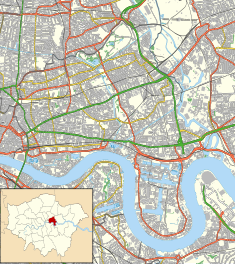St George's Town Hall
| St George's Town Hall | |
|---|---|
 St George's Town Hall | |
| Location | 236 Cable Street, Stepney E1 0BL |
| Coordinates | 51°30′39″N 0°03′30″W / 51.5109°N 0.0584°W |
| Built | 1860 |
| Architect | Andrew Wilson |
| Architectural style(s) | Classical style |
Listed Building – Grade II | |
| Designated | 11 April 1990 |
| Reference no. | 1242346 |
St George's Town Hall, formerly known as Stepney Town Hall, and, before that, St George's Vestry Hall, is a municipal building on Cable Street, Stepney, London. It is a Grade II listed building.[1]
History[edit]
In the mid-19th century the local vestry board met in a room on the south-west corner of the Church of St George in the East.[2] Board members decided this arrangement was inadequate for their needs and that they would procure a purpose-built vestry hall for the Parish of St George: the site chosen was to the north-east of the church and already formed part of the church grounds.[3]
The vestry hall, the western section of the current complex, was designed by Andrew Wilson in the Classical style and was completed in 1860.[4] The design involved a symmetrical main frontage with five bays facing onto Cable Street; there was a porch with Doric order columns and pilasters and a triglyphed frieze projecting from the central section and a row of windows interspersed with Ionic order columns on the first floor.[1] A cornice bearing the words "Erected AD 1860" was added at roof level.[1] The principal room was the board room (subsequently termed the council chamber) located on the first floor at the front of the building.[4]
On 1 October 1888 the inquest into the death of Elizabeth Stride, the third victim of the Whitechapel murders, was held in the building.[5][6]
The building was extended eastwards by adding an extra three bays to the five bays that already existed in a similar style in 1899; it went on to become the headquarters of the Metropolitan Borough of Stepney as "Stepney Town Hall" in 1900.[7] The area in front of the town hall was the scene of the Battle of Cable Street on Sunday 4 October 1936 when a clash took place between the Metropolitan Police, sent to protect a march by members of the British Union of Fascists, led by Oswald Mosley, and various anti-fascist demonstrators.[8] A mural, which was painted on the side of the building, in the early 1980s, to depict these events, was restored in the early 21st century.[8][9][10]
The building ceased to function as the local seat of government when the enlarged London Borough of Tower Hamlets was formed in 1965.[11] It subsequently became the home of various community organisations including St George's Boxing Club.[12] After the building was converted for commercial use in the 1990s,[4] a community centre, managed by Unite the Union, was established in the basement in 2013.[13]
References[edit]
- ^ a b c Historic England. "St George's Town Hall, Tower Hamlets (1242346)". National Heritage List for England. Retrieved 15 May 2020.
- ^ "History of the parish & its principal church". St George in the East Church. Retrieved 15 May 2020.
- ^ "Ordnance Survey Map". 1851. Retrieved 15 May 2020.
- ^ a b c "London's Town Halls". Historic England. p. 189. Retrieved 15 May 2020.
- ^ Jack the Ripper: The Complete Casebook ISBN 978-1-977-37535-3 p. 76
- ^ Yost, Dave (2008). Elizabeth Stride and Jack the Ripper: The Life and Death of the Reputed Third Victim. McFarland & Co. ISBN 978-0786433186.
- ^ "Limehouse Town Hall springs back to like after leaky roof is fixed". East London Advertiser. 12 April 2012. Retrieved 9 April 2020.
- ^ a b "Cable Street: 'Solidarity stopped Mosley's fascists'". BBC News. 4 October 2011. Retrieved 13 October 2015.
- ^ "The Faded Grandeur Of London's Old Town Halls". The Londonist. 30 April 2013. Retrieved 15 May 2020.
- ^ "The lost east end" (PDF). Discovering Britain. Retrieved 15 May 2020.
- ^ "Local Government Act 1963". Legislation.gov.uk. Retrieved 25 April 2020.
- ^ "Sammy tells his story of bygone boxing era". East London Advertiser. 15 August 2014. Retrieved 15 May 2020.
- ^ "Unite Community Centre, Shadwell" (PDF). London Borough of Tower Hamlets. 29 April 2013. Retrieved 15 May 2020.

